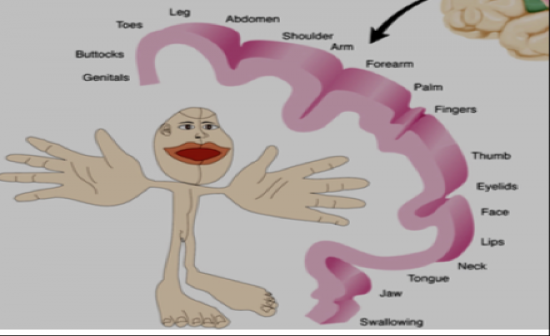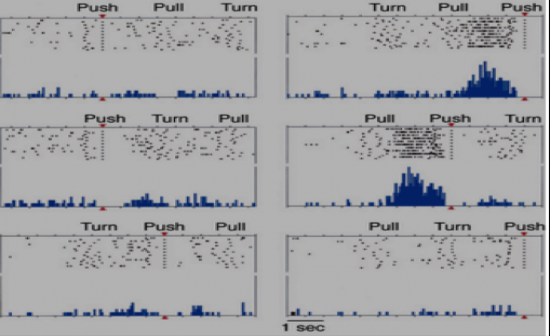Cards In This Set
| Front | Back |
|
Motor Homunculus
|
 · disproportionate amount of cortical area is devoted to movements of the fingers and the muscles used for speech |
|
Stimulation of Motor Cortex (Grazaiano and Aflalo)
|
· Prolonged stimulation of specific regions of the cortex produces complex movements.
no somatotopical representation. just because you feel something doesn't mean it will move |
|
Primary motor cortex (M1)
|
· major input of cortical sensorimotor signals and the major output of sensorimotor signals is to the descending motor pathways that initiate movement; located on the precentral gyrus
|
|
M1 continued
|
O Organized in terms of particular movements of particular parts of the body
o Commands for movement initiated in the motor cortex are assisted and modified-most notably, by the basal ganglia and the cerebellum o Also receives projections from the adjacent primary somatosensory cortex; neurons in the p.s.c. that respond to stimuli applied to a particular part of the body send axons to neurons in the primary motor cortex that move muscles in the same part of the body (rapid feedback to motor system when manipulating objects) |
|
somatotopic organization
|
O a topographically organized mapping of parts of the body that are represented in a particular region of the brain
|
|
Georgopoulos, Kettner, Schwartz (monkeys)
|
O Movement appears to be based on a “vote" of a population of neurons in a particular region
|
|
Evarts
|
O Recorded the activity of a single neurons in the precentral gyrus of monkeys
o Monkeys moved lever back and forth by means of wrist flexions and extensions o Rewarded when they did it in the correct amount of time o Then trained them to do a hand movement in response to flash of light or tactile stimulus delivered through handle o Hand and finger movements are controlled by somatosensory feedback received by neurons in the postcentral gyrus |
|
supplementary motor area (SMA)
|
Located on the medial surface of the brain
|
|
Premotor cortex
|
-located primarily on the lateral surface
· The SMA and the premotor cortex receive sensory information from the parietal and temporal lobes |
|
Role of the Motor Association Cortex
|
· Supplementary motor area and the premotor cortex are involved in the planning of movements, through their connections with the primary motor cortex
· Involved in imitating the actions of other people · Parietal lobes are involved in organizing visually guided movements “how” of visual perception · Regions of frontal cortex involved in planning movements receive the information they need about what is happening and where it is happening from the temporal and parietal lobes |
|
Supplementary Motor Cortex (SMA) 2
|
· It is involved in learning and performing sequences of movements
· Monkeys with lesions to the SMA are unable to perform a simple two-sequence response: pushing in a lever and then turning it to the left |
|
Neural Activity in Monkey SMA (Shima and Tanji)
|
 O Monkeys were taught six sequences of three motor responses (e.g. push-pull-turn or turn-push-pull etc.) o Neurons in SMA were recorded. The activity of these neurons encoded certain elements of the sequence o The SMA was then temporarily inactivated with muscimol (a GABA agonist which inhibits neural activity) --After inactivation, monkeys could still reach for an object or make a response, but they could not perform the sequence of three responses that they had previously learned PICTURE o Firing pattern of single neuron in SMA. This neuron fires only when a push response follows a pull response |
|
SMA activity in Humans
|
· In humans, learned sequences of button presses activate the SMA (Hikosaka et al)
· When SMA is disrupted with TMS (Transcranial Magnetic Stimulation) in people who learned to play 16 finger presses on a piano, the subject continue to play for about one second after stimulation but then reported that they ‘did not know which series of keys to press next’ (Gerloff et al) o SMA is involved in planning the elements yet to come in sequences of movements |
|
Pre-SMA
|
· a region just rostral to the SMA is thought to be involved in the desire to move (perception of control of spontaneous movements). If we stimulate these regions, it provokes an urge to make a movement or you anticipate that a movement is about to occur
· Information received from the parietal lobes permits the pre-SMA to detect that a decision to move has been made |
|
Premotor Cortex
|
· is involved in learning and executing complex movements that are guided by sensory information
· Movement can be guided by nonarbitrary (directed, visual information tells you where it is) or arbitrary information (no visual information to guide or direct you, it’s a non spatial response) must be learned · Monkeys with premotor inactivation using muscimol are able to move their hands towards a signal light located to the left or right (a nonarbitrary stimulus), but were not able to make previously learned left and right movements in response to arbitrary red and green stimulus lights (Kurate and Hoffman 1994) · Humans with premotor damage can made several different movements in response to spatial cues but cannot make a specific movements in responses to arbitrary visual, auditory or tactile stimuli |



